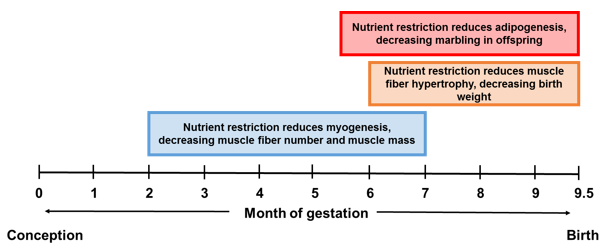
Cliff Lamb, Beef Cattle Specialist, University of Florida – North Florida Research and Education Center, Marianna, FL
Fetal programming is a term that many producers may have heard of in recent years, but may not have understood the concept. The concept of fetal programming, also known as developmental programming, was first introduced in humans and referred to as “the Barker hypothesis.” Essentially, this concept states that during critical prenatal development stages lasting impacts on postnatal growth and adult function may occur. Fetal growth is thought to be set at an early stage in development and environmental insults may alter subsequent functions such as growth, health, and reproduction. These functions appear to be caused by epigenetic (non-genetic influences) changes in gene expression in the embryo leading to further changes in fetal development.
From a cattle standpoint, many factors influence livestock nutrient requirements including breed, season, and physiological function. Fetal programming responses can result from a negative nutrient environment, which can be caused by 1) breeding of young dams who compete for nutrients with rapidly growing fetal systems; 2) increased incidences of multiple fetuses; 3) selection for increased milk production, which competes for nutrients with increased energy demand from fetal and placental growth; or 4) breeding of cattle during high temperatures and pregnancy occurring during periods of poor pasture conditions. It has been reported in research that compromised maternal nutrition during gestation (pregnancy) resulted in increased calf mortality, intestinal and respiratory dysfunction, metabolic disorders, decreased postnatal growth rates, and reduced meat quality. Therefore, nutritional management of cows during gestation may enhance performance and health of calves.
A majority of fetal growth occurs during the last two months of gestation; however, during the early phase of fetal development critical events for normal embryo development occur, including differentiation, circular system, fetal organ, and placental development. The fetal organs develop at the same time as development of the placenta and limbs, which start as early as day 25 of gestation. Following limb development is a sequential development of other organs including the pancreas, liver, adrenal glands, lungs, thyroid, spleen, brain, thymus, and kidneys. In male calves, testicular development is initiated by day 45 and ovarian development begins in female fetuses by day 50. Therefore, with functional organs developed early in fetuses, adequate blood flow and nutrients to the fetus are critical for further development. Figure 1 demonstrates where nutrient restriction during gestation may impact muscle and fat cell formation and subsequent fetal and calf development. The approximate ranges depicted in the figure are estimated mainly based on data from studies in sheep, rodents, and humans, and represent the progression through the various developmental stages summarized by Du et al., 2010 (Du et al. 2010. J. Anim. Sci. 88 (E. Suppl.):E51-E60.

A few studies have demonstrated the link between maternal nutrition and subsequent offspring performance. One study indicated that steers from dams who had been nutritionally restricted during gestation had reduced body weights, and consequently reduced carcass weights at slaughter. In addition, calves from cows who had been provided supplemental protein during gestation had increased birth weights, which indicates a potential alteration in fetal muscle growth. Similarly, when cows received protein supplementation in late gestation, calves from supplemented cows had increased adjusted 205 day weaning weights, prebreeding weight, weight at pregnancy diagnosis, and improved pregnancy rates compared to heifers from dams who did not receive protein supplementation. Another advantage noted, was that heifers from cows that received supplemental protein during late gestation also had a decreased age at puberty and tended to have higher pregnancy rates compared to heifers from non-supplemented dams. Therefore, it appears that nutritional management during gestation may have implications on subsequent calf development.
Proper maternal nutrition during gestation appears to enhance calf health. For example, research has shown increased sickness and death rates in calves born to females receiving 65% of their dietary energy requirement during the last 90 days of gestation, compared to calves from females receiving 100% of their energy requirement. One factor contributing to the increased increased sickness and death rates is a decreased birth weight. Calves born to nutrient restricted dams were 4.5 lb lighter at birth, compared to calves from dams receiving adequate nutrition.
Therefore, management of maternal diet beginning during early gestation will ensure proper placental programming resulting in adequate nutrient transfer to the developing fetus. Maternal nutrition later in gestation appears to influence fetal organ development, muscle development, postnatal calf performance, and reproduction. Although the mechanisms by which placental and fetal programming occur are not clear, managing resources to ensure proper cow nutrient intake during critical points of gestation can improve calf performance and health.
For more information on this subject, download:
Fetal Programming – Implications for Beef Cattle Production
 0
0
